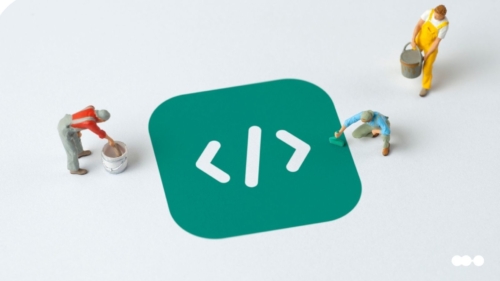
Processes are the heart of a business, and how well they work has a direct impact on business success. But how those processes get implemented and managed has changed in recent years.
Following the pandemic, many industries learned that collaboration and work management methods are no longer sufficient to keep pace with the rapid rate of change in business processes. To solve this, it’s now clear that digital experiences are the key to automating existing workflows and building coordinated processes that make cross-collaboration possible.
In this low-code webinar, citizen developers from Lacoste and Ocean Network Express share why digitization is essential to process management and how they transformed their processes with a low-code business process automation platform.
Below is a recap of the webinar and key insights from:
- Vinicius Castro, Operations and Digital Projects Manager at Lacoste
- Sergio Marques, Business Process Senior Analyst at Ocean Network Express
- Kristen Davis, Product Evangelist and Director of Solutions Marketing at Pipefy
- Luiz Eifler, Customer Marketing Analyst at Pipefy
- Justin Sears, Chief Marketing Officer at Pipefy
Key terms and definitions
Workflow management is the identification, organization, and coordination of a particular set of tasks that produce a specific outcome.
Business process automation, or BPA, is the automation of complex business processes and functions beyond conventional data manipulation and record-keeping activities. While BPA is a newer term, it refers to a subset of activities in the more familiar concept of business process management.
Low-code BPA makes the automation of complex processes easier, giving business teams the power to improve and automate their processes — in addition to sparing IT teams from an incessant inflow of requests. Low-code BPA is sometimes referred to simply as “low-code automation.”
Citizen developer is a persona, not a title or a targeted role. Citizen developers report to a business unit or function other than IT and are typically employees who create application capabilities for consumption by themselves using IT- and unit-sanctioned tools.
Why these terms are important
They are important because, when combined, they create a powerful solution for common business problems. BPA connects workflows and dissolves silos, which improves workflow management. Low-code BPA empowers citizen developers to make necessary process improvements and automations.
In the end, all four components orchestrate business processes to run faster, more efficiently, and more effectively.
Business units need agility. IT needs control. See how no-code delivers both with No-Code Automation: Good for Business, Great for IT
Digital experience transformation success stories
Processes are the foundational element of how things get done within an organization. With workflow automation, any type of business process can be automated and orchestrated, allowing leaders to both articulate what the business needs and provide employees the tools to build that application.
Here’s how two global companies and Pipefy customers were able to create experiences that digitally transformed their processes by using automation to streamline and improve their operations.
Ocean Network Express: Digitized manual, paper-based finance processes
Challenge
Ocean Network Express (ONE) has a fleet of 220 ships, making it the ONE is the world’s sixth-largest maritime transportation business and offers services to 106 countries around the globe.
The Finance team needed a solution for their accounts payable processes which were manual and decentralized, and, until the beginning of 2020, were managed through emails, spreadsheets, and paper approvals. “That was the main reality of our finance teams,” Marques says.
Processes for payment approval or payment request were done over email with external parties, and using these outside systems further complicated their internal finance processes once the team brought the work in-house.
“We had to lead everything with the printing,” Marques says. “This involved managing the hard copy of the invoicing, asking for signatures for payment approval, sending the payment approval to another department through email — and sometimes even sending the actual paper itself — so everything was being handled in a manual way.”
But when the pandemic began in 2020 and the company was ordered home, the manual way of operating was no longer a realistic standard. This left Marques’ team wondering: How would they handle all approvals and all the communication through email remotely?
“At the beginning, it was very crazy and very difficult for everyone because the number of emails started increasing,” Marques says. “We used to communicate face-to-face and then we had to do everything by email, so we lost track of a lot of things even though we tried to keep control.”
The finance team began implementing controls and using spreadsheets to keep the process on track, but the work became difficult to manage and standardize. Shortly after the team began working from home, it became clear that they needed a platform, system, or tool to fit all of their processes in this new reality.
Solution
The pandemic made the team realize that process digitalization existed and it was time for them to do it.
“Right now, I could not see myself doing things the way we were in the past,” Marques says. “At the start of the pandemic and before Pipefy, we tried finding workarounds to our problems. We started online forms to gather information, using email to exchange data and communicate. It was not ideal, but it at least covered what we were needing, and that was the communication. But with everyone working from home, the number of requests kept increasing and soon it became too difficult to manage the work and the communication.”
As time went by, it became harder for the team to know whether an email related to an invoice or payment was actually received or noticed, so the finance team began to grow worried about the long-term impact the immediate workaround would have on all related processes, as well as the quality of work they provided. “This was the trigger to try to look for something that could help us.”
Pipefy’s capability to centralize all communication within a single platform was what drew the ONE team, but it was the process orchestration capabilities and visibility into all operations that convinced them that low-code automation was the right solution.
“We saw this tool in the market that did what we were looking for, so we presented it to the finance team,” Marques says. “The finance team made their analysis and said okay, let’s give it a shot. We actually started with a prototype that we made to see what we could get from Pipefy, how the communication would work, and what ways that we could find to try to improve the process.”
After running the prototype, the team understood how Pipefy could help with a primary issue: communication. “It allows us to communicate with other processes, and that triggers new ideas for the future.”
Results
“When people ask me about Pipefy, I tell them about the centralization and data organization that Pipefy allowed us to have within processes,” Marques says. “Before Pipefy, we were receiving information in a lot of different ways, we were registering the information in different systems, and using different support tools to keep track of what was happening. Pipefy helped us with this decentralization, so now all the information is received inside Pipefy. We were also able to automate our workflows and create rules to make things go faster than if the user had to validate tasks themselves.”
With Pipefy, the finance team is able to define the flow of all the steps that need to be performed, from the moment that the vendor sends an invoice until payment is posted. Pipefy also lets the team assign who is responsible for what step in the process, and — with process automation — triggers kick off the process and alert responsible parties the moment invoices are received. “They receive the notification and move forward within Pipefy without the need to communicate between each other.”
Lacoste: Eliminated manual refund process & improved customer experiences
Challenge
The challenge Lacoste’s e-commerce operations team faced directly affected customers requesting refunds. In order to refund customers, Lacoste must pay back customers by transferring the specified money amount from the company to customer bank accounts. This process involves the company’s tax team, account team, several areas of customer service, and the customer, and was managed via Excel spreadsheets, email communication, and manual paperwork.
This level of manual process management led to errors and created additional hours of manual processing and rework.
“To refund one single customer, I don’t know how many trees I’m killing due to all this paper that I’m getting,” Castro says. It was not a smart way to work and it was affecting our customers, which was the most important. We were taking too long to refund our customers.”
Frustrated with the existing process and its toll on Lacoste’s customer experience, Castro remembered Pipefy from an experience at a prior company. “I sent my problem to Pipefy and asked what they could do for me. After one or two weeks, they sent me a working process and I thought: ‘Let’s buy Pipefy.’”
Solution
“Luckily, we were planning to get Pipefy before the pandemic, so we were ready to work better but our situation was pretty similar to Sergio’s,” Castro says.
By digitalizing the existing process and setting up the process designed by Pipefy, the team was ready for what came next.
“Because of the pandemic, had we not started this process with Pipefy when we did, it would have been impossible to perform all these processes, manage all these departments, and keep track of things across paper, Excel, and email,” Castro says. “Because we were able to get Pipefy before the pandemic, I was able to see how much time of my life I saved with it.”
Results
“For part of my process, I need to get customers’ bank information,” Castro says. “In the past, I had to call them or send an email. Now Pipefy does this for me, so I’m saving a lot of time for the customer service team because they don’t need to get on the phone and call the customer.”
Pipefy’s centralized view also saves additional time by eliminating the need to track down the status of tasks. “I know where things are,” Castro says. “I can see how many cards are with this department and can call the department manager to see what they can do to speed up these cards. In the past, it was impossible to have this holistic view of the process.”
The result of these improvements cut down the time it took to issue customer refunds by 50% — resulting in a positive impact on the finance team and the customer experience. “We were spending almost 50 days to refund a customer, and now it takes 20-25 days.”
The updated and streamlined process led to faster refund times, happier customers, and better brand positioning. “We’re now able to understand bottlenecks and can improve the process itself,” Castro says.
Following the success of this “pilot” process with Pipefy, the next steps are to expand efforts and implement Pipefy across Lacoste’s eight Latin American offices.
“We have already implemented Pipefy in Panama, Colombia, Peru, and Venezuela. The intention is to implement Pipefy across all eight offices starting with the finance process and then, if in the future we see opportunity, in other areas as well.”
Why citizen developers need low-code automation
Businesses need improved collaboration, but a lack of tools or IT bandwidth can make that impossible. Here are two examples of how low-code platforms can empower citizen developers like Marques and Castro from ONE and Lacoste.
Example 1: A VP of a finance team is swamped and is experiencing issues like:
- A lack of coordination creates delays in delivery times.
- No visibility into process performance.
- Decentralized supplier information.
Combined, all of these issues impact customer satisfaction, create delays, and introduce errors that can ultimately affect the team’s performance and relationships with suppliers.
Example 2: An employee is concerned that existing processes are making their team’s performance appear slow and sloppy. The team’s challenges include:
- A lack of work traceability and visibility.
- Ineffective work management due to manual information tracking via email.
In both of these examples, creating and automating new processes can be seen by IT as time-consuming and expensive — resulting in requests to be added to the IT backlog. In addition to this, updated processes may not be what teams need because IT is less familiar with business processes.
By empowering citizen developers to identify challenges, and develop and deploy solutions using low-code automation platforms, businesses can gain agility, improve collaboration and partnership with IT, and experience better process performance.
ICYMI: Low-code webinar series recaps and insights
Unable to attend previous webinars? Don’t miss out on industry-leading conversations and insights. Check out our previous low-code webinar series recaps to keep informed:
Low-Code Webinar Series Recap: Why Low-Code Is Key to Digital Transformation, featuring guest speaker Carlos Cima, Vice President of Technology at SoftBank Group International.
Low-Code Webinar Series Recap: How IBM and Pipefy Navigate the Digital Landscape With Low-Code Solutions, featuring guest speaker Guilherme Novaes, Ecosystem Director at IBM Brasil.
Low-Code Webinar Series Recap: How Accenture Made Low-Code the Backbone of Digital Transformation and Innovation, featuring guest speakers Fabiano Guastella, Digital Innovation Associate Director at Accenture, and Clarison Benteo, Digital Transformation Manager at Accenture.
When it comes to process automation, you have options. Read the Buyer’s Guide to Automation Platforms to learn about the strengths and limitations of each of the major automation options available today.
*Some comments and quotes have been edited for clarity.







